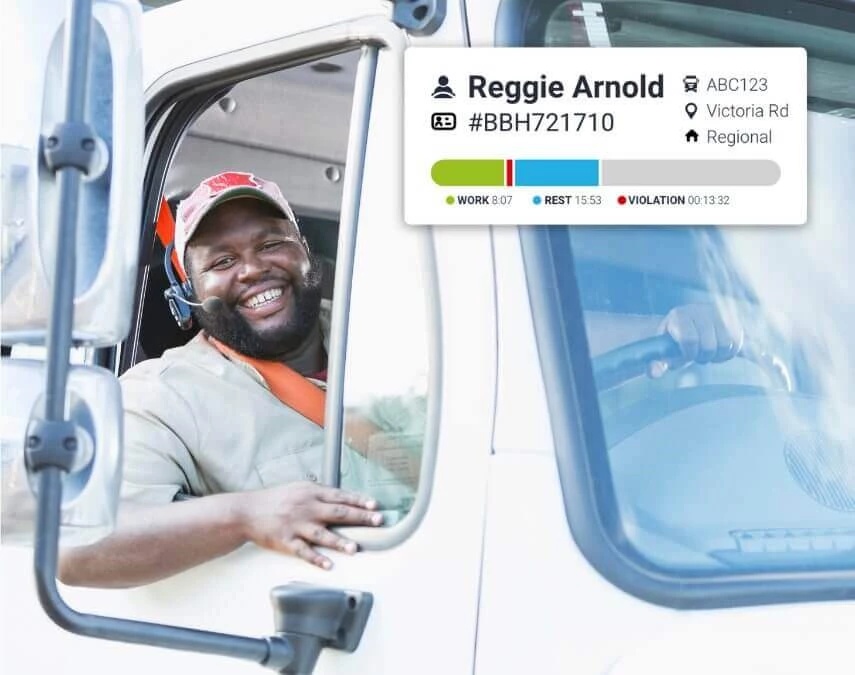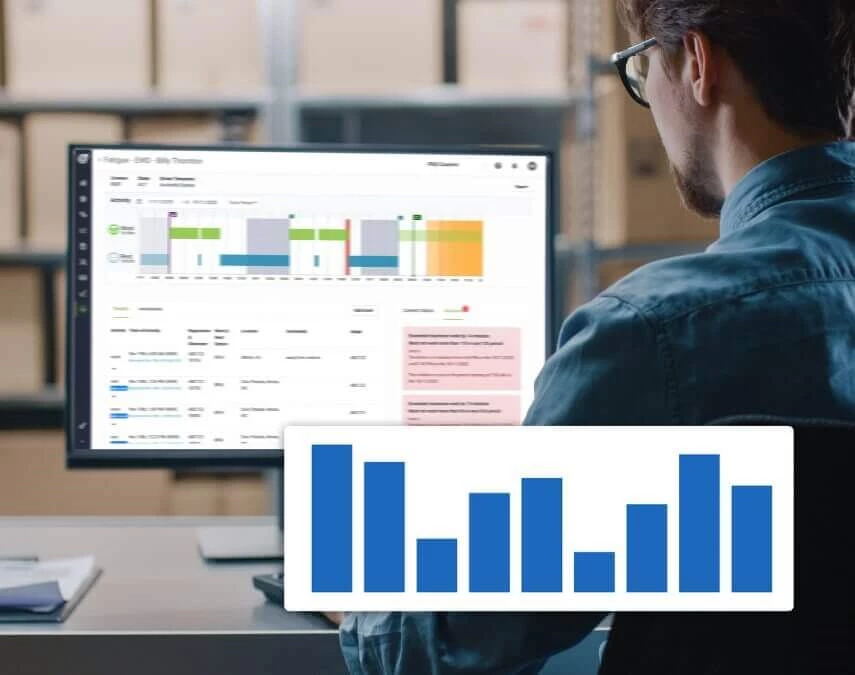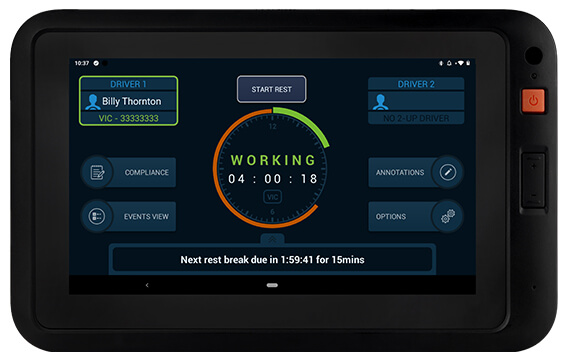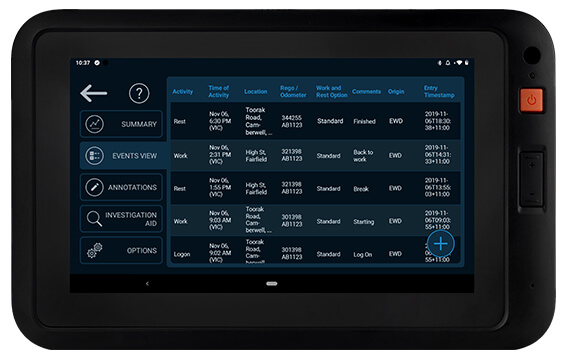Simplify your fatigue management processes with an NHVR-approved Electronic Work Diary
By going digital with your fatigue management, you can entirely eliminate the need to rely on the dated paperwork diary that is fraught with inaccuracies and is easily damaged or misplaced, forcing you to be reactive to fatigue compliance violations. You can reduce risk, eliminate guesswork and improve scheduling with Teletrac Navman's NHVR-approved EWD that has a proven track record. Exceed expectations with a solution that helps drivers safely get on with their day instead of worry about when they're legally required to rest and when they can get back on the road.
Get a demo Download Free eBook
Eliminate paperwork and manual processes with a digital system that gives you real-time information about your driver's work and rest hours.
Reduce risk and safety concerns by getting ahead and managing fatigue hours proactively before violations occur to help with compliance to regulated hours.
With an EWD, the complexities of calculating hours based on rulesets is taken away as the solution completes all the calculations for you.
Improve scheduling with real-time and historical insights into hours worked to help your drivers stay safe and compliant.
A digital fatigue system can help the business & its drivers to automate the entire process.
Built over 15 years of industry and customer experience into a system that is designed for transport.

While drivers may be comfortable with written work diaries, they can be fraught with inaccuracies, and rely on an individual’s interpretation of the fatigue rules, and the understanding and ability to calculate work and rest period requirements.
Depending on a driver’s schedule, the back-office may only lay eyes on written work diary days, or even weeks after jobs are complete, when it’s too late to directly address any problems. Furthermore, keeping track of Australia’s complicated legislation can be a job in itself, especially when it’s constantly being refined – and certain states like Western Australia that have their own fatigue rules, creating confusion for those crossing the border.
These challenges can be overcome with the use of Electronic Work Diaries (EWDs), which deliver a multitude of safety, cost and time-saving benefits. While EWDs have traditionally been used to record work and rest hours in addition to a written work diary. Today, EWD solutions are available and approved by the National Heavy Vehicle Regulator (NHVR) that can be solely used, without a PWD, to manage driver fatigue.
"We’ve seen a huge decrease in fatigue breaches using the Electronic Work Diaries. They let us better keep track of driver hours. We match up the real data with the physical logbooks and the drivers are getting better and better at logging their time and maintaining safe hours.”
Ange Marlow, Administration Manager, Porthaul
The driver is able to view their current status, tap to start work or rest during every journey, view rest break calculations, available work hours and all relevant data on the device. An EWD offers a number of advantages over written work diary.

Taking breaks while driving is important for your health and safety. With EWDs, drivers are notified before a rest break is required based on their work hours completed, making it easier for drivers and businesses to ensure compliance. EWDs make fatigue easy to understand by breaking down the fatigue rules based on the driver’s real-time status and giving them enough information to make the best possible decisions on the road.

With an EWD, you are able to treat each day as if an audit is about to occur, with real-time information at your fingertips. Reports are compiled in a few simple clicks and easily exported. Additionally, driver non-compliance and outcomes an be recorded. This means time wasted combing through piles of misfiled, damaged or lost paperwork is eliminated. It automates the audit process, removing duplication and data-entry errors.

Traditionally, written work diaries aren’t handed to back office staff until the end of shift, which can often be days later. Once the logbook has been checked, only then do you have the chance to say, “This breach is pretty serious, let’s sit down and talk about it.” At that stage, your driver may not remember what happened, where, or even why. With EWDs, drivers have access to immediate information and customisable alerting to make sure work and rest hours are being complied with.

Having access to real-time fatigue information across your entire fleet helps you to correctly allocate jobs while allowing appropriate work and rest times. It lets you assign jobs based on available hours and removes the guesswork from your driver’s schedules. This provides a new level of assurance in knowing that your drivers aren’t over worked and will be completing the journey within legal limits.

As a digital solution, EWDs remove the cost of labour-intensive paperwork entirely, as driver information is automatically synced as it’s collected. By reducing the admin involved in manual log book checking it saves your business time and money. It reduces interruption to the driver’s work, and makes processes simpler. Your efforts can be put into more strategic initiatives such as winning new contracts, while further improving safety initiatives.

The same device that delivers you the EWD solution also centralises a variety of tools for drivers, providing a platform where they can complete checklists, receive messages, record progress of jobs and complete necessary forms – all on a single device. It streamlines driver processes and makes life that much simpler!
“The administration side of things has improved 100 per cent. Previously, we were doing double the data entry, as drivers would compile their own information and back-office staff would have to enter it into our systems. Now, this no longer has to be done twice, and staff have more time to concentrate on what they’re supposed to be working on.”
Scott Guthrie, Systems Manager, Mt Noorat Freighters
The manual process behind keeping written work diaries can become a burden for back office staff and drivers – particularly when you’re managing a large-scale business. Staying on top of compliance and safety can be incredibly challenging.
Find out more
Drivers get real-time work and rest information to help them better manage their own fatigue compliance.
With complete event and rule data based on the ruleset and driver hours, all help to provide complete picture to the driver.
Proactively get ahead of your hours and get alerted when you require a rest break based on the ruleset.
Based on your requirements, there are two different versions available. The complete NHVR-approved EWD or Sentinel, a digital solution designed to augment the logbook and help drivers complete their paperwork diary.

Operating within a fully featured in-cabin environment, the driver has the power to manage their fatigue directly via a digital system. It provides up-to-date information and a complete compliance workflow for enforcement, giving the driver confidence of their compliance within an easy-to-use system. With a long list of features that provide the business with flexibility to operate productively. Better allocation of tasks and accountability of work hours, Teletrac Navman’s Electronic Work Diary powers the operation to proactively manage fatigue and compliance.

Teletrac Navman’s Sentinel is a digital fatigue management solution designed to help drivers keep track of their work and rest hours. At the same time, it gives businesses real-time transparency of when drivers are available to better schedule jobs. It gives real-time insight into available hours, fatigue summary information, rest break requirements and more. With real-time driver feedback for upcoming rest breaks or violations, drivers can use the information to better plan their journey while on the road. If a driver goes into breach, real-time back-office alerts are generated allowing for appropriate action to be taken. Meets all fatigue rule sets including standard hours, BFM, Bus, AFM, and WA Main Roads fatigue recording system.
There’s a lot to know and learn about. Here’s some more information!